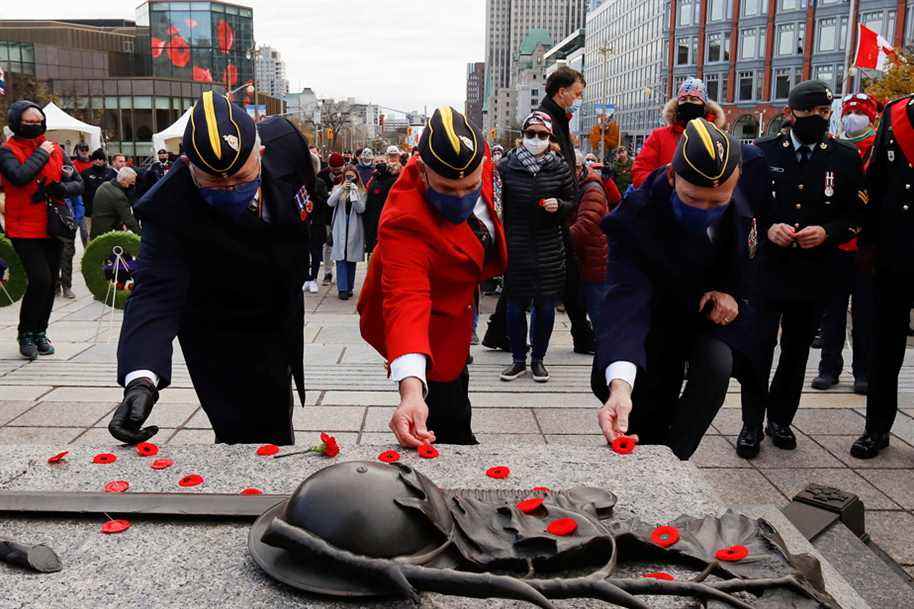(Ottawa) Clear blue masks rubbed shoulders with red poppies on a chilly November morning Thursday as Canadians gathered at cenotaphs and memorials across the country to remember and pay tribute to those who died in the service of the country and for freedom.
This year’s Remembrance Day ceremonies contrasted sharply with those of last year, in the midst of the second wave of the pandemic, when organizers discouraged citizens from attending in person.
Since the founding of the country, more than 2.3 million Canadians have donned military uniforms and more than 120,000 have made the ultimate sacrifice of their lives.
In Ottawa, thousands of people stood quietly behind metal barriers as a cold wind tore leaves from the trees near the National War Memorial, while political and military dignitaries stood silently to attention before laying wreaths.
Among those in attendance were Governor General Mary May Simon, new Defense Minister Anita Anand, and Acting Chief of Staff General Wayne Eyre, all of whom attended their first ceremony on Remembrance in their current functions.
Mme Anand, who was sworn in as defense minister just three weeks ago, replaced Harjit Sajjan after months of criticism over his response to allegations of sexual misconduct targeting the highest echelons of the Armed Forces.

PHOTO PATRICK DOYLE, REUTERS
A veteran lays a poppy at the Tomb of the Unknown Soldier in Ottawa.
“The first thing we need to do on Remembrance Day is remember the sacrifices our soldiers past and present have made for our country,” Mr.me Anand. “And my role as Minister of National Defense is to ensure that the Canadian Armed Forces continue to be an institution where everyone can feel safe, respected and protected. And that’s what I will continue to do every day. ”
Governor General Simon, for her part, noted that this year marks the 70e anniversary of the Battle of Kapyong, during the Korean War, and the 15the anniversary of the death of the first Canadian in combat, Captain Nichola Goddard.
The poppy is 100 years old
This year’s Remembrance Day also marks the centenary of the poppy, a symbol of remembrance in this country, inspired by John McCrae’s poem “In Flanders Fields”.
“We are dead / We who were still thinking the day before / Of our parents, of our friends / We are the ones who rest here / In the field of honor. ”
Prime Minister Justin Trudeau said on Thursday that 100 years later, the poppy remains an unmistakable symbol of dark days.
At the National War Memorial in Ottawa, the “Act of Remembrance” was read again in English, French and an Aboriginal language – this year the Métchif language, spoken by Métis people. The “Act of Remembrance” is an excerpt from the poem “For the Fallen”, by Laurence Binyon: “When will the hour of twilight / And that of dawn / We will remember them”.
M. Trudeau and Mme Simon arrived long minutes later than expected, due to the discovery of a suspicious package near the cenotaph. The ceremony was already underway when the Royal Canadian Mounted Police safely cleared the package, allowing dignitaries to arrive.
Canceled parades
The Royal Canadian Legion had again canceled the traditional Veterans’ Parade in Ottawa, which in the past saw very elderly WWII and Korean War veterans marching alongside younger servicemen, missions and conflicts. more recent.
Solemn ceremonies were also held in other communities across the country, including Toronto, Halifax, Saint John, Iqaluit and Charlottetown.
In Montreal, where the public was not invited to appear in person, a few dozen soldiers and a handful of dignitaries gathered for a ceremony in front of the cenotaph in Place du Canada.
In Quebec City, Premier François Legault attended a ceremony on the Plains of Abraham and met the widow of a soldier. The day before, he had inaugurated the Léo-Major route, a Quebec hero of the Second World War and the Korean War, in the area of the Valcartier base.
Veterans wounded in their souls
Conservative Leader Erin O’Toole, himself an Air Force veteran, said that “our veterans and those who serve today represent the very best in ‘be a Canadian’.

PHOTO PATRICK DOYLE, REUTERS
Prime Minister Justin Trudeau participated in the commemorations Thursday.
The leader of the Bloc Québécois, Yves ‑ François Blanchet, paid tribute to “soldiers from Quebec and Quebec (who) demonstrated an unusual sense of duty and commitment”.
His colleague Luc Désilets, spokesperson for the Bloc with Veterans Affairs, stressed for his part that several veterans had also “succumbed, on the margins of society, to the pangs of deep physical and psychological wounds and largely ignored”.
NDP Leader Jagmeet Singh also highlighted the suffering of some veterans. “For too long, the government has failed to meet their needs, which explains the increase in the rate of homelessness and mental health problems among those who have served our country,” he said.
In anticipation of Remembrance Day this year, questions had been raised as to the possibility of lowering the Canadian flag on November 11 when it had already been half mast since mid-May in honor of the children who died in federal residential schools for Aboriginal people.
The government finally gave instructions on Sunday to hoist the Canadian flag on public buildings, so that it could be half-masted again on Thursday. The maple leaf was also half mast on Monday, National Indigenous Veterans Day.
